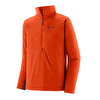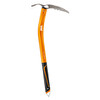Corsica rock climbing

 1 / 11
1 / 11 Maurizio Oviglia
Maurizio Oviglia
Multi-pitch rock climbs in Corsica are a world unto themselves, perhaps even more fascinating than the beautiful single pitch crags on this Mediterranean island. The local climbers realised the potential many years ago and the choice of routes is astounding. While the number of limestone routes can be counted on the fingers of a hand, the granite outings abound and areas such as the Bavella can rightly be considered a granite paradise in the heart of Europe.
The fact that areas such as the Bavella and Restonica are less famous than others does not mean that they are less beautiful or interesting than say Valle dell?Orco or Val di Mello in Italy. Their relative popularity is simply due to the fact that the locals have kept a low key approach, jealously guarding their mineral wealth in the hope that its wild inner soul remains untouched.
There are at least a thousand multi-pitch routes up beautiful granite rock in Corsica. Which means that we'll have to tighten our search criteria, as one does on the internet...
|
|||||||||||||||||||||||||||||||||||||||||||||||||||||||||
If we're interested in modern routes and not "terrain d'aventure" as one calls it in France, then the choice is still vast, but it obviously excludes a large number of climbs which are truly adventurous, and not only because they aren't bolted! The approaches are notoriously complicated (across intricate Mediterranean shrub) and the information provided by the first ascentionists is (purposefully) concise. All of this is worse than it may seem at first appearance, above all for those used to climbing in the Alps. Taking the wrong path can turn into a drama, unless of course you have a machete of flame-thrower! And despite having all the relevant information to hand, you'll certainly experience something similar and see for yourselves!
If we're interested in bolt routes then one has to chose between real big-wall style routes, those semi-equipped (at times extremely difficult indeed out of the question for the vast majority), or those which climb easier terrain. Choosing this second option one still needs to distinguish between those route which have a relatively humane approach and those which force you to wander across Mediterranean shrub for 4 hours without a path to follow.
So the choice has been made, by now you'll certainly have understood what types of routes are on offer in this introduction to multi-pitch rock climbs in Corsica. Even if the adventure aspect is limited slightly, you will nevertheless enjoy astounding panoramas in beautiful surroundings. The areas I've chosen are in my mind the most beautiful: Bavella and Restonica, and the beautiful valleys close to Corte. The routes are relatively easy and well protected, and trad gear is often not needed. But a word of caution: this doesn't mean that the routes are bolted like a route at a crag, or that they are simple!
Two 55m or 60m ropes and a helmet are necessary for all these outings, and the best time of year is either spring or autumn. Summer can be scorching hot and the routes on the Teghie Lisce at Bavella can seem practically impossible.
CORSICA FACTSHEET
Getting there
Corsica can be reached by plane or by ferry. The main ports are Ajaccio, Bastia and Bonifacio. The main airports are Ajaccio, Bastia, Calvi and Figari.
Moving about
The Corsican roads are infamous for being narrow and winding. Except of the main road down the east coast, pay particular care when cars come from the opposite direction, and remember that the local inhabitants often do not use the horn. A recommended trip could be to reach Corte from Bastia and visit the surrounding valleys. Bavella, the second area described in this article, can be reached via the east coast from Solenzara or via a long and winding road via Ghisoni and Quenza.
Bavella
Bavella is one of Europe's granite paradises. It is comprised of a series of towers (called Aiguilles) located around Col de Bavella, and a large number of smaller rock faces in the lateral valleys. Some Rock formations are reminiscent of the Sardinian Gallura, with rounded granite domes, while others are more alpine, true rocky summits. The slabs at Polischellu (Teghie Lisce) are grandiose: apparently unclimbable, they really are a corner of Yosemite right in the heart of the Mediterranean. The area is completed with the isolated rock faces at Tafunata di Paliri and all those where the eyes wander, distant and difficult to reach.
Restonica
This is a long valley which starts from Corte and penetrates into the heart of the Corsican mountains, up to Monte Renoso at 2600m. The environment is less wild than Bavella and more alpine. Some routes are situated at circa 2000m, above beautiful deep blue lakes. Numerous classic climbs abound in the Restonica valley. The approaches tend to be less complicated and across easier terrain than the Mediterranean shrub.
Tavignano
This valley starts from Corte and continues almost flat for a couple of kilometers. Although less alpine than Restonica, the valley offers some splendid rock faces, especially in the middle section. The River Tavignano has created some beautiful crystal clear pools, much to the joy of summer bathers. The grantie domes Capu Aliri in the upper section of the valley are so distant that they are best reached from the adjacent Valle del Golo (Calacuccia).
Accommodation
Wild camping is strictly prohibited in Corsica. Given the fact that the campsites are not particularly expensive, we recommend you make best use of these. Personally I recommend the campsite just outside Corte located next to river Restonica and the municipal campsite at Zonza, cheap and relatively un-crowded.
Best time of year
The best time of year to climb in Corsica is in autumn.
The rock
The ochre Corsican granite is riddled with pockets of all shapes and sizes and these can be surprisingly large and beautiful at both Bavella and Tavignano where at times its features are similar to those found on limestone! In other areas the rock is similar to alpine gneiss.
In-situ gear
The gear varies considerably from one route to the next, from old 8mm bolts to modern 10mm stainless steel bolts. The run-outs vary considerably, too.
Gear
Apart from all the normal gear or modern routes (12 quickdraws, screw-gata carabines, prussik loops, 2 50m ropes, helmet) we recommended a selection of nuts and friends and some carabiners for the abseils. Don't forget a swimsuit for a dip in the lake or rivers.
The climbs
Most routes are classic granite climbs which ascend technical rock faces. The routes at Rossolino are athletic, while those at Punta dell?Acellu climb off-width cracks. Furthermore, there are
Weather forecast
The French weather forecast is excellent.
Accommodation
Wild camping is strictly prohibited in Corsica. Given the fact that the campsites are not particularly expensive, we recommend you make best use of these. Personally I recommend the campsite just outside Corte located next to river Restonica and the municipal campsite at Zonza, cheap and relatively uncrowded.
Bibliography
Sport climbing in Corsica
Maurizio Oviglia. Italian and English, Versante Sud
Guide d'escalade en Corse, Tome I. Jean Paul Quilici and Bernard Vaucher, Ed. de l'Envol, 2000, in French. All the multi-ptich routes in an exhaustive traditional guidebook. Photos of the routes, but no topos.
Corse, l'ile verticale. Martial Lacroix e Pierre Sanchou, Ed. Adrénaline, 1999, in French. An exhaustive selection of 72 beautiful multi-pitches in Corsica. Some approaches described very haphazardly.
| Links Planetmountain | |
| Rock climbing in Corsica | |



 Copia link
Copia link









 See all photos
See all photos






















